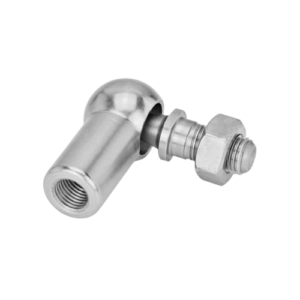Joint Types
DIN 71802 Standard Joint
The DIN 71802 standard specifies the dimensions, material properties and technical requirements of such fasteners used primarily in industrial and automotive applications.
A joint according to the DIN 71802 standard generally consists of an external thread connector, an internal thread connector and a ball-shaped joint. These joints are designed to provide rotary movement and connection flexibility. These fasteners can be customized for many applications and are available in different sizes and capacities.
These types of joints are used primarily in applications such as industrial machinery, vehicles, construction equipment and assembly lines. Joints allow fasteners to move at various angles and are therefore used where rotation, bending or angular movement is required.
Joints conforming to the DIN 71802 standard are generally available from various industrial suppliers and fastener providers. The dimensions, capacities and material options of these joints may vary depending on the needs of your project and the characteristics of your application.
Joint Types
Joint:
Joints are a connecting element used to connect two rotating shafts and transmit rotary motion at different angles.
It is generally used in vehicle transmission systems, truck steering systems and industrial machines.
Joints can transmit rotary motion by connecting two shafts operating in different angular positions.
This type of joints consists of internal threaded rods, external threaded housings and connecting pins.
he advantages of joints include the ability to work at different angles and high durability.
Bellows Joint:
Bellows joints are a type of fastener that provides a connection between two rotating shafts or axles.
These joints are used to correct angular deviations between rotary axes and reduce vibration in machines.
Bellows joints provide the rotating connection between the two ends of a bellows. The elastic structure of the bellows can tolerate angular deviations between the rotary axes.
They are especially used in precision measuring instruments, medical devices and precision machinery.
The advantages of bellows joints include compact design, low vibration transmission and resistance to corrosive environments.
Split Joint:
Split joints are a fastener that has a rod that can be slid over the shaft or rod of a joint.
These joints are used in applications where a shaft or rod that is adjustable in length must be joined or adjusted.
They are especially widely used in assembly lines, conveyor systems and various machine assemblies.
Advantages of split joints include ease of assembly and adjustability of length.
Factors Causing Changes in Joint Strength:
Joint strength, or the load a joint can carry, varies depending on a number of factors. The main factors affecting the strength of the joint may be:
- Material: The material used to make the joint has a large impact on its strength. For example, steel joints generally provide high strength, but materials such as stainless steel or aluminum may have lower strength.
- Dimensions: The dimensions of the joints affect the load it can carry. Larger diameter joints can generally carry more load.
- Connection Structure: The connection structure and design of the joints have a great impact on their strength. For example, how contact is made between two surfaces and how tightly these surfaces are joined affects strength.
- Direction of Load Application: The direction of the load applied to the joint can have an effect on its strength. Rotational loads, pushing or pulling loads along the axis can affect the strength in different ways.
- Number of Joints: There may be more than one joint in an assembly, and the way these joints work together affects the strength of the assembly.
- Conditions of Use: The operating conditions of the joints have a great impact on their strength. In particular, factors such as extreme temperature, chemical effects or vibration can negatively affect the strength.
- Aging and Fatigue of Joints: Fatigue and deformation of joints over time may reduce their strength. Therefore, maintenance and regular control of the joints is important.
The maximum load that the joint can carry varies according to the technical data specified by the manufacturer and the design of the joint. To use a functional and safely operating joint, the strength requirements of the particular application or assembly must be taken into account. Therefore, when choosing a joint, it is important to choose a joint that suits the usage conditions and application requirements.

